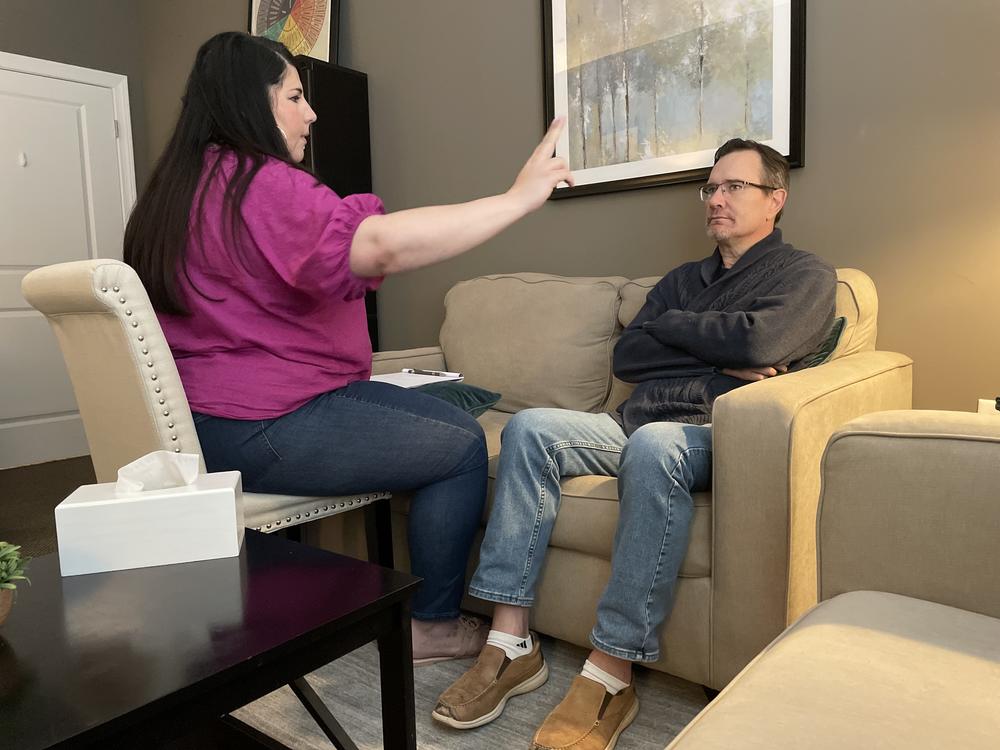
Caption
Marlo Taylor hold up her fingers during an Eye Movement Desensitization and Reprocessing therapy session with Jess Geyerman.
Credit: Ellen Eldridge / GPB News
|Updated: August 25, 2023 9:12 AM
LISTEN: Intrusive thoughts. Anxiety attacks. Poor sleep. Traumatic experiences can haunt people. And many struggle to move on, even through a range of therapies. But for some, one therapy using eye movement is helping turn past traumas into experiences to learn from — and heal. GPB’s Ellen Eldridge reports.

Marlo Taylor hold up her fingers during an Eye Movement Desensitization and Reprocessing therapy session with Jess Geyerman.
Marine veteran Jess Geyerman wasn't depressed before sustaining a traumatic brain injury in the mid-1990s.
"It was one of the major factors that forced me to give up my career, which really got to me," he said over lunch at a burger joint in Woodstock owned by former Marines.
The bar and grille, decorated with military memorabilia, is closed Mondays, but offers free pie every Tuesday.
That and an ambiance of "everyone welcomed; veterans and first responders honored" fills the dining room every week with folks like Geyerman.
After his honorable discharge in 1997, multiple surgeries to help neck pain caused by the TBI left Geyerman worse off in body and mind.
“The first two weren't a problem but, obviously, the third paralyzed me,” he said.
Chronic pain is not only physical; it's emotional.
"I had a hard time adjusting," he said. "(I had) just started trying to go to school while I was fighting with the VA for disability."
He joked that he chose to study psychology in college because he wanted to understand his own messed-up mind.
Geyerman said his post-traumatic stress disorder started with the event that caused his TBI.
"I relived the crash many times," he said. "I became extremely anxious and hyper-vigilant as a passenger."
The combination of physical and mental injuries forced Geyerman to give up his career. He felt severe depression and anxiety that went from nightmares and waking up screaming to intense insomnia for years.
"It all made me feel like I was losing my grip on sanity," he said.
Talking about it didn’t help.
"Definitely (would) be more helpful to do something where you're not expected to whole hog go right into, you know, whatever is the most traumatic thing or whatever is depressing you, period," Geyerman said, "and have to explain it to a virtual stranger."
Geyerman tried antidepressants, but pills didn't work.
There are multiple clinical trials showing that antidepressant medications and antidepressant psychotherapy don’t work for people’s traumatic brain injury.
Neither did ketamine, a less traditional antidepressant medicine, work to keep the negative thoughts away.
So, today, he’s trying something new, called eye movement desensitization and reprocessing therapy — EMDR for short.
Geyerman is already struggling when his 10 a.m. appointment begins.
"I just woke up to the news this morning that a friend of mine killed himself ... And I'm not having a great day."
GPB isn't reporting Geyerman’s full session, to respect his privacy. But therapist Marlo Taylor said the first step in an EMDR session is picking a traumatic moment to focus on; to visualize in the mind.
There is no need to talk in detail about the distressing issue, and the client is not asked to complete homework between sessions. Rather than focusing on changing the emotions, thoughts, or behaviors resulting from the distressing issue, EMDR therapy allows the brain to resume its natural healing process.
Taylor explained how the technique works.
"The client holds that image in mind along with the negative cognition that's associated with it," she said. "So something like, 'I'm not good enough, I'm helpless, I'm stuck.'"
Then the therapist asks the client to track her moving fingers with his eyes.
Every few minutes, they talk about feelings.
"Some clients may feel a tightness in their chest or that their throat feels like it's closing, or their hands feel clammy," Taylor said.
Taylor reminds clients that “feelings aren’t facts.”
But, she said, those feelings felt in the body do reinforce how we remember traumatic experiences. Think about how you might tense your shoulders after an unpleasant memory.
Taylor said EMDR focuses on resetting that connection between the body and the brain at the same time, allowing the client to reprocess a memory that was improperly stored.
Angie Heath is the community coordinator for the Georgia EMDR Network of about 150 certified specialists. But she estimates hundreds of therapists throughout the state are using EMDR techniques for people with PTSD.
"These are really pretty horrific memories that people hold, so we always know that they're going to have some type of emotional charge," Heath said. "They're going to be sad. They're going to be hard to look at; like, you know, nobody's ever going to take 9/11 and think, you know, ‘Oh, it wasn't that bad.’ Like, it was intense."
Back in his EMDR session, Jess Geyerman said he opted not to start with the most intense memory.
"This was not one of the top 10 traumatic moments," he said. "It was a good one to start with."
After therapy, Geyerman said he was amazed. And as incredible as this might sound, he said he could feel therapy working even before the session was over.
"I didn't anticipate it being as effective as it was," he said. "Not in such a short period. Uh, I'm — I've had a lot of optimism about this going forward. That was pretty profound."
That was months ago. Now Geyerman says he’s been using EMDR therapy and working through memories one by one, since then.
He says he’s still amazed.
Geyerman is one of the roughly 8% of Georgians who've served in the military.
As many as 20% of military service members live with post-traumatic stress disorder, which often leads to substance use disorders and suicidal behavior, and nearly 200 military veterans living in Georgia died by suicide in 2020.
If you or someone you know is having thoughts of suicide, contact the Veterans Crisis Line to receive free, confidential support and crisis intervention. It’s available 24 hours a day, 7 days a week, 365 days a year. Dial 988, then press 1; chat online at VeteransCrisisLine.net/Chat; or text 838255.
